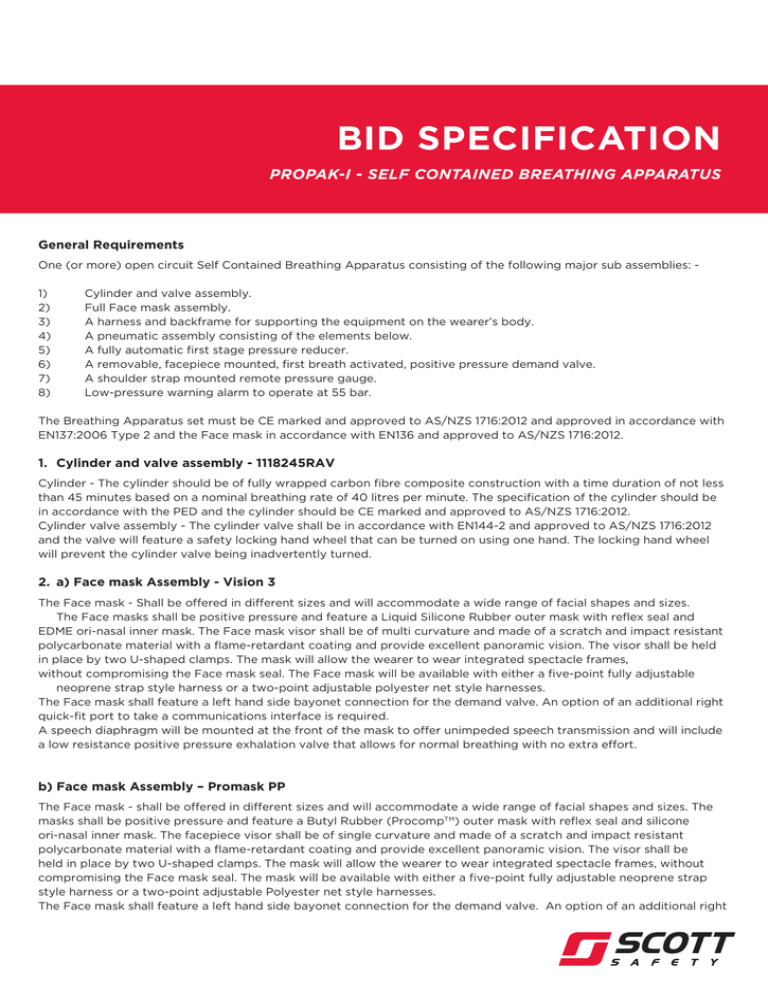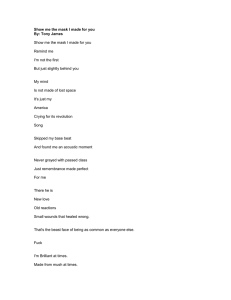
BID SPECIFICATION
PROPAK-I - SELF CONTAINED BREATHING APPARATUS
General Requirements
One (or more) open circuit Self Contained Breathing Apparatus consisting of the following major sub assemblies: 1)
2)
3)
4)
5)
6)
7)
8)
Cylinder and valve assembly.
Full Face mask assembly.
A harness and backframe for supporting the equipment on the wearer’s body.
A pneumatic assembly consisting of the elements below.
A fully automatic first stage pressure reducer.
A removable, facepiece mounted, first breath activated, positive pressure demand valve.
A shoulder strap mounted remote pressure gauge.
Low-pressure warning alarm to operate at 55 bar.
The Breathing Apparatus set must be CE marked and approved to AS/NZS 1716:2012 and approved in accordance with
EN137:2006 Type 2 and the Face mask in accordance with EN136 and approved to AS/NZS 1716:2012.
1. Cylinder and valve assembly - 1118245RAV
Cylinder - The cylinder should be of fully wrapped carbon fibre composite construction with a time duration of not less
than 45 minutes based on a nominal breathing rate of 40 litres per minute. The specification of the cylinder should be
in accordance with the PED and the cylinder should be CE marked and approved to AS/NZS 1716:2012.
Cylinder valve assembly - The cylinder valve shall be in accordance with EN144-2 and approved to AS/NZS 1716:2012
and the valve will feature a safety locking hand wheel that can be turned on using one hand. The locking hand wheel
will prevent the cylinder valve being inadvertently turned.
2. a) Face mask Assembly - Vision 3
The Face mask - Shall be offered in different sizes and will accommodate a wide range of facial shapes and sizes. The Face masks shall be positive pressure and feature a Liquid Silicone Rubber outer mask with reflex seal and
EDME ori-nasal inner mask. The Face mask visor shall be of multi curvature and made of a scratch and impact resistant polycarbonate material with a flame-retardant coating and provide excellent panoramic vision. The visor shall be held
in place by two U-shaped clamps. The mask will allow the wearer to wear integrated spectacle frames, without compromising the Face mask seal. The Face mask will be available with either a five-point fully adjustable neoprene strap style harness or a two-point adjustable polyester net style harnesses.
The Face mask shall feature a left hand side bayonet connection for the demand valve. An option of an additional right quick-fit port to take a communications interface is required.
A speech diaphragm will be mounted at the front of the mask to offer unimpeded speech transmission and will include a low resistance positive pressure exhalation valve that allows for normal breathing with no extra effort. b) Face mask Assembly – Promask PP
The Face mask - shall be offered in different sizes and will accommodate a wide range of facial shapes and sizes. The
masks shall be positive pressure and feature a Butyl Rubber (ProcompTM) outer mask with reflex seal and silicone
ori-nasal inner mask. The facepiece visor shall be of single curvature and made of a scratch and impact resistant
polycarbonate material with a flame-retardant coating and provide excellent panoramic vision. The visor shall be
held in place by two U-shaped clamps. The mask will allow the wearer to wear integrated spectacle frames, without
compromising the Face mask seal. The mask will be available with either a five-point fully adjustable neoprene strap
style harness or a two-point adjustable Polyester net style harnesses.
The Face mask shall feature a left hand side bayonet connection for the demand valve. An option of an additional right
BID SPECIFICATION
quick-fit port to take a communications interface is required.
A speech diaphragm will be mounted at the front of the mask to offer unimpeded speech transmission and will
include a low resistance positive pressure exhalation valve that allows for normal breathing with no extra effort.
3. Harness and Backframe Assembly
The backframe shall be manufactured from glass & carbon filled Nylon composite.
The harness shall be manufactured from Kevlar blend webbing and feature unpadded shoulder straps and padded
waistbelt. The harness shall include a fully adjustable waist belt using a double pull forward action with a quick
release plastic buckle.
The cylinder shall be held on the backframe by a KevlarTM and PyrogardTM blend webbing cylinder band, with an over
centre latching glass filled polyamide buckle . A double action steel locking catch will prevent accidental opening.
The cylinder band shall be adjustable, without the use of tools and shall secure all cylinders specified in 1) above.
The reducer/cylinder connector shall support the cylinder valve at the lower end of the backframe to support the
cylinder assembly.
4.Pneumatics
The pneumatics assembly will consist of the elements listed below. The assembly should be able to be removed
quickly and easily from the set with out the use of tools and without breaking into the pneumatics. Therefore when
removing the pneumatics from the set and replacing them back onto the set they should not need to be retested.
5. First Stage Pressure Reducer
The first stage pressure reducer shall be mounted in a protected position on the rear, lower portion of the
backframe. The pressure reducer shall be of a fail-safe spring-loaded piston design, with an integral pressure relief
valve, consisting of only two moving parts.
The reducer shall be completely automatic, low maintenance and require no calibration. The reducer shall have flow
characteristics that exceed 650 lpm and be protected by a pressure relief valve that operates between 11.5 and 13.5
bar. The pressure reducer shall incorporate an internal flow restrictor leading to a supply gauge hose that will limit
the airflow to less than 25 lpm, preventing rapid air loss should the gauge supply hose become severed or damaged.
The reducer shall be designed to function with either 200 or 300 bar cylinders. The cylinder connector shall accept
both 200 and 300 bar cylinders and shall be joined directly to the reducer. The cylinder connector should have a
sintered filter that can be removed and changed without having to take the cylinder connector apart.
6. Demand Valve
The positive pressure demand valve shall provide air, on demand to the wearer, utilising a servo-assisted tilting
diaphragm mechanism providing peak flow in excess of 1000 lpm, while maintaining a static positive pressure of 1 5 mbar inside the facepiece. The demand valve shall connect to the Face mask via a quarter turn bayonet fitting on
the left of the Face mask.
The demand valve reducer shall feature an automatic first breath mechanism, which prevents the loss of air during
the donning procedure. The regulator is to be equipped with a true bypass valve which, when rotated to the on
position, provides a nominal constant flow of air (150 lpm) to the Face mask for emergency use and to purge the
system when depressurising.
7. Pressure Gauge
The unit shall feature a 300 bar pressure gauge to monitor cylinder pressure at the input of the first stage reducer.
It will feature a luminous dial, indicating 0-350 bar. The gauge shall be shoulder strap mounted and capable of being
pulled close up to the Face mask for use in poor visibility. The gauge shall be equipped with a blow-out vent and the
gauge shall feature a rubber shroud for impact protection.
8. Low Pressure warning alarms
The unit shall feature low-pressure warning alarm that will operate at 55 bar. The alarm shall be a warning whistle,
mounted next to the pressure gauge.
Australia: Scott Safety*
PO Box 876, Guildford NSW 2161, Australia
Phone 131 772 Fax 1800 651 772 Email: scott.sales.anz@tycoint.com
* Scott Safety is a division of Rindin Enterprises Pty Limited ACN 089330914
www.scottsafety.com
(Australia/New Zealand)
© Scott Safety. All rights reserved all other trademarks are the property
of their respective owners.
New Zealand: Scott Safety
Private Bag 93011, New Lynn, Auckland, New Zealand
Phone (64 9) 635 0760 Fax (64 9) 259 3963
Email: scott.sales.anz@tycoint.com

